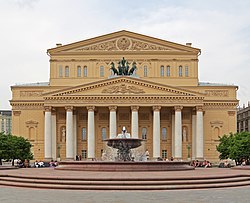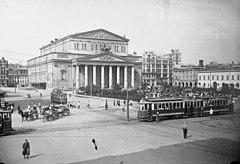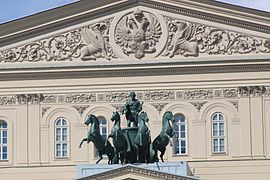Bolshoi Theatre
55°45′37″N 37°37′07″E / 55.76028°N 37.61861°E
Большой театр | |
 Bolshoi Theatre in 2012 | |
| Address | Teatralnaya Square 1 Tverskoy District, Moscow Russia |
|---|---|
| Public transit | Teatralnaya or Okhotny Ryad (Moscow Metro) |
| Construction | |
| Opened | 1825 |
| Architect | Peter Ouroussoff,Michael Maddox |
| Website | |
| www | |
The Bolshoi Theatre (Russian: Большо́й теа́тр, romanized: Bol'shoy Teatr. Translation: Big Theatre, IPA: [bɐlʲˈʂoj tʲɪˈatər]) is a historic theatre in Moscow, Russia, designed by architect Joseph Bové, which holds performances of ballet and opera. The theatre's original name was the Imperial Bolshoi Theatre of Moscow, while the St. Petersburg Bolshoi Theatre (demolished in 1886), was called the Imperial Bolshoi Kamenny Theatre.
At that time, all Russian theatres were imperial property. Moscow and St. Petersburg each had only two theatres, one intended for opera and ballet (these were known as the Bolshoi Theatres), and one for plays (tragedies and comedies). Because opera and ballet were considered nobler than drama, the opera houses were named "Grand Theatres" ("Bolshoi" is Russian for "large" or "grand") and the drama theatres were called the "Smaller Theatre" ("Maly" is Russian for "small", "lesser", or "little").
The Bolshoi Ballet and Bolshoi Opera are amongst the oldest and most renowned ballet and opera companies in the world. It is by far the world's biggest ballet company, having more than 200 dancers.[1] The theatre is the parent company of The Bolshoi Ballet Academy, a world-famous leading school of ballet. It has a branch at the Bolshoi Theatre School in Joinville, Brazil.
The main building of the theatre, rebuilt and renovated several times during its history, is a landmark of Moscow and Russia (its iconic neoclassical façade is depicted on the Russian 100-ruble banknote). On 28 October 2011, the Bolshoi was re-opened after an extensive six-year renovation.[2] The official cost of the renovation is 21 billion rubles ($688 million). However, other Russian authorities and other people connected to it claimed much more public money was spent.[3][4] The renovation included restoring acoustics to the original quality (which had been lost during the Soviet Era), as well as restoring the original Imperial decor of the Bolshoi.[2]
History






Origins
The company was founded on 28 March 1776 by Prince Pyotr Vasilyevich Ouroussoff and Michael Maddox. Initially, it held performances in a private home, but it acquired the Petrovka Theatre and on 30 December 1780 it began producing plays and operas, thus establishing what was to become the Bolshoi Theatre. With the destruction by fire of the Petrovka Theatre on 8 October 1805, it was replaced on 13 April 1808 with the opening of New Arbat Imperial Theatre, but, as a consequence of the French invasion of Moscow in 1812, fire destroyed that theatre.
The current theatre was built on Theatre Square between 1821 and 1824. It was designed by architect Andrei Mikhailov (who had also built the nearby Maly Theatre in 1824) and it opened on 18 January 1825 as the Bolshoi Petrovsky Theatre with a performance of Fernando Sor's ballet, Cendrillon. Initially, it presented only Russian works, but foreign composers entered the repertoire around 1840.
Renovations in the 19th Century
In 1843 a large-scale reconstruction of the theatre took place using a design by A. Nikitin, but a fire in 1853 caused extensive damage and so a further reconstruction was carried out, by Alberto Cavos, son of the opera composer Catterino Cavos. On 20 August 1856 the Bolshoi Theatre reopened. Other repairs of the building took place in 1896.
20th Century
On 7 December 1919 the house was renamed the State Academic Bolshoi Theatre. Only a few days later, however, on 12 December, there was an unsuccessful attempt to shut the institution down entirely. Beethoven Hall opened on 18 February 1921. There was further reconstruction of the theatre between 1921 and 1923 under the auspices of Ivan Rerberg. Bomb damage occurred during World War II, but this was promptly repaired.
New Stage of 2002
A new stage for the Bolshoi Theatre, called the New Stage, went into service on 29 November 2002. It was built to the left of the theater's historic main stage. Together with auxiliary buildings — a restored 17th-century building, two rehearsal halls, and artists' recreation rooms — it forms a single theater complex, the Bolshoi Theatre of Russia. The new building is on a natural hill where, until recently, there were blocks of old houses with communal apartments.[5]
Major Rebuilding and Renovation (2005–2011)
From July 2005 to October 2011 the theatre was closed for restoration. It had undergone many renovations in its time, but none as major as this. The building, whose architecture combines three different styles, was damaged and a quick renovation seemed to be necessary.
Repairs were initially due to cost 15 billion rubles ($610 million) but engineers found that more than 75% of the structure was unstable,[6] and as a result the cost estimate jumped to 25.5 billion rubles (app. $850 million). At the completion of the work, however, it was announced that only 21 billion rubles ($688 mil) had been spent.[7] According to The Moscow Times, the true cost may have been double that,[3] and Der Spiegel quotes a figure of $1.1 billion.[4] The rebuilding and renovation was funded entirely by the federal government.[8]
During the long period of reconstruction, the company continued to mount productions, with performances held on the New Stage and on the stage of the Great Kremlin Palace.
The renovation included an improvement in acoustics, to attempt to replicate the sound believed to have existed in pre-Soviet times,[9] and the restoration of the original Imperial decor.[2] The building's foundation and brickwork were thoroughly reset. Inside, the entire space was stripped from the bottom up. The 19th-century wooden fixtures, silver stage curtain and French-made red velvet banquettes were removed for repair in specialist workshops. Outside, on the top of the façade, the double-headed eagle of the original Russian coat of arms was installed in the place where the Soviet hammer and sickle had been mounted for decades.
Finally, on 28 October 2011, the Bolshoi Theatre re-opened with a concert featuring international artists and the ballet and opera companies.[2] The first staged opera, Ruslan and Lyudmila, followed soon after.
Notable Premieres
The Bolshoi has been the site of many historic premieres, including:
- Tchaikovsky's The Voyevoda and Mazeppa
- Modest Mussorgsky's one version of Boris Godunov was given on 16 December 1888.
- Rachmaninoff's Aleko and Francesca da Rimini
- Nikolai Rimsky-Korsakov's opera The Maid of Pskov, with Feodor Chaliapin singing the role of Ivan the Terrible
- Dmitri Shostakovich's opera Lady Macbeth of the Mtsensk District in 1935.
Other Notable Facts
- The first symphonic concert by the Bolshoi Orchestra took place at the Bolshoi Theatre on 4 May 1919, conducted by Serge Koussevitzky
- Leonid Sobinov, Antonina Nezhdanova, Ksenia Dzerzhinskaya, Galina Vishnevskaya, and dozens of other outstanding opera singers have performed at the Bolshoi.
- The formal proclamation that the Soviet Union had been officially established was made from the stage of the Bolshoi.
Ballet and Opera


The Bolshoi is a repertory theatre, meaning that it draws from a list of productions, any one of which may be performed on a given evening. It normally introduces two to four new ballet or opera productions each season and puts a similar number on hold. The sets and costumes for most productions are made in the Bolshoi's own workshops. The performers are drawn primarily from the Bolshoi's regular ballet and opera companies, with occasional guest performances. Since the dissolution of the Soviet Union, there have been a few attempts to reduce the theatre's traditional dependence on large state subsidies. Corporate sponsorship occurs for some productions, but state funding is still the lifeblood of the company.
The Bolshoi has been associated from its beginnings with ballet. Tchaikovsky's ballet Swan Lake premiered at the theatre on 4 March 1877. Other staples of the Bolshoi repertoire include Tchaikovsky's The Sleeping Beauty and The Nutcracker, Adam's Giselle, Prokofiev's Romeo and Juliet, and Khachaturian's Spartacus.
The chief ballet conductor from 1923 to 1963 was Yuri Fayer.
After the death of Joseph Stalin, the company toured internationally and became an important source of cultural prestige, as well as foreign currency earnings. As a result, the "Bolshoi Ballet" became a well-known name in the West. However, the Bolshoi suffered from losses through a series of defections of its dancers. The first occurrence[10] was on 23 August 1979, with Alexander Godunov; followed by Leonid Kozlov and Valentina Kozlova on 16 September 1979;[11][12] and other cases in the following years. Bolshoi continues to tour regularly with opera and ballet productions in the post-Soviet era.
The opera company specializes in the classics of Russian opera such as Mussorgsky's Boris Godunov, Glinka's A Life for the Tsar, and Rimsky-Korsakov's The Tsar's Bride, as well as the operas of Tchaikovsky. Many operas by western composers are also performed, especially works of Italian composers such as Rossini, Verdi, and Puccini. Until the mid-1990s, most foreign operas were sung in Russian, but Italian and other languages have been heard more frequently on the Bolshoi stage in recent years.
Some operas, such as Borodin's Prince Igor, include extensive ballet sequences. Many productions, especially of classic Russian opera, are performed on a grand scale, with dozens of costumed singers and dancers on stage for crowd or festival scenes.

Orchestra
The orchestra of the Bolshoi Theater is a virtuoso ensemble in its own right. It gives occasional concerts of symphonic music in the theater and elsewhere, and has made recordings. Over the decades, it has toured overseas as the "Bolshoi Theater Orchestra," the "Bolshoi Symphony Orchestra" and, most recently, as the "Bolshoi Orchestra."
Its music director and chief conductor, Vassily Sinaisky, quit abruptly at the start of December 2013, after a 41-month tenure, citing the need to avoid conflict. His resignation was promptly accepted by general director Vladimir Urin, who then selected Tugan Sokhiev as the replacement. Sokhiev's contract, settled on January 20, 2014, runs for four years and was effective immediately. The new chief also holds conductorships in Toulouse and Berlin.
Chief Conductors and Music Directors
|
|
|
Cultural Status

The Bolshoi Theatre is famous throughout the world. It is frequented by tourists. As a result, prices can be much higher than in other Russian theatres. This is especially the case for ballet, where prices are comparable to those for performances in the West. For local citizens, concerts and operas are still relatively affordable, with prices ranging from 100 rubles (for students, for balcony seats for matinée performances) to 15,000 rubles (for seats in the orchestra or stalls).
Scandals
- The rebuilding and renovation cost was $1.1 billion,[4] sixteen times the initial estimate. In 2009 prosecutors alleged the lead contractor was paid three times for the same work.[1]
- Anastasia Volochkova, a former Bolshoi prima ballerina, has said she sees the theater "as a big brothel" because, she has claimed, ballerinas are invited to parties by theater administrators and refused roles if they do not accept.[1][4]
- On 17 January 2013, Sergei Filin, the Bolshoi's ballet director, was attacked with sulfuric acid and as a result lost much of his eyesight.[15] A male dancer was later charged with the crime.
- In the area of box office, a theater insider told the German publication Der Spiegel that tickets are often sold to mafia dealers, who in turn sell them on the black market for double the face value.[4]
- Performance quality has been criticized by the former music director Alexander Vedernikov (2001-2009). He has claimed the Bolshoi Theater was putting "bureaucratic interests before artistic ones."[1]
See also
References
- ^ a b c d Elder, Miriam (22 March 2011). "Bolshoi rocked by scandal and intrigue | Stage | The Guardian". Retrieved 26 October 2015.
- ^ a b c d "Bolshoi Theatre to reopen after major refit", BBC News on bbc.co.uk, 28 October 2011
- ^ a b Bolshoi Theater to reopen after restoration The Moscow Times, retrieved 11 Feb 2013
- ^ a b c d e Jealousy and corruption rumors surround attack on Bolshoi director, Der Spiegel, retvieved 11 Feb 2013
- ^ The New Stage of Bolshoi Theatre, See You in Moscow
- ^ Saving Bolshoi Theater New York Times, 4 February 2008
- ^ "Bolshoi Theater raises curtain after six-year restoration". RIA Novosti. 28 Oct 2011. Retrieved 29 Oct 2011.
- ^ "Bolshoi to reopen late in 2009 after rescue work" "Entertainment", on reuters.com
- ^ "The State Academic Bolshoi Theatre of Russia: Reconstruction & Renovation: Theatre Reconstruction" on bolshoi.ru/en
- ^ Turmoil on the Tarmac TIME Magazine, September 3, 1979
- ^ "Today in History - September 18". WorldofQuotes. Retrieved 2011-10-30.
- ^ "Brouhaha at the Bolshoi" TIME Magazine, October 1, 1979
- ^ Conductor exits left as Bolshoi Theatre's woes mount[dead link]
- ^ Amie Ferris-Rotman (2010-09-21). "New musical director opens Bolshoi's 235th season". Reuters. Retrieved 2011-06-01.
- ^ Bolshoi boss Sergei Filin leaves hospital for Germany
Footnotes
- The Bolshoi Kamenny Theatre used to exist in Saint Petersburg. It stood next to the Circus Theatre (rebuilt in 1860 as the Mariinsky Theatre), but it was replaced in the 1890s by the present-day building of the St. Petersburg Conservatory. It was at St. Petersburg's Bolshoi that the first great Russian operas, Glinka's A Life for the Tsar and Ruslan and Lyudmila, premiered.
- In a bit of ideological editing, the Bolshoi Theatre appears to be "destroyed" by the device of a split screen in Dziga Vertov's Man with a Movie Camera.
External links
- Official Bolshoi Theatre website Template:En icon
- Official Bolshoi Theatre webpages YouTube
- Official Bolshoi Theatre webpages Facebook
- Official Bolshoi Theatre webpages VKontakte
- Official Bolshoi Theatre webpages Twitter
- Official Bolshoi Theatre webpages Instagram
- Bolshoi Theatre in Theatrical Russia Annual Dictionary
- For Ballet Lovers Only: Bolshoi dancers of the past and of today in biographies and photos
- Chief Conductors
- Bolshoi Theatre School in Brazil website
- Bolshoi Delights Cuba Audience Photo Feature, Havana Times, Feb 15, 2010
- Reconstruction of Bolshoi Theatre, Pictures
- The New Stage of Bolshoi Theatre, Pictures

